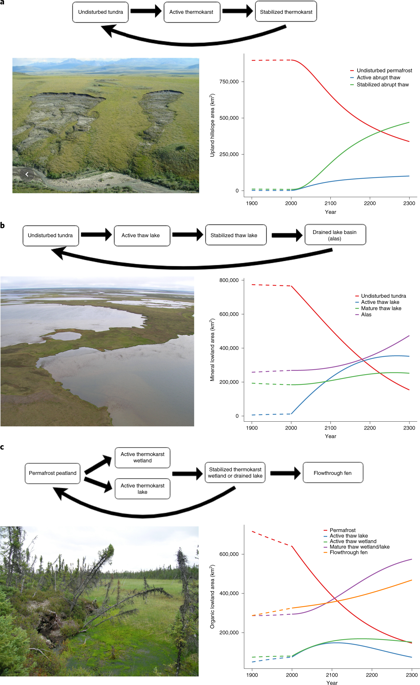Nature Geoscience ( IF 15.7 ) Pub Date : 2020-02-03 , DOI: 10.1038/s41561-019-0526-0 Merritt R. Turetsky , Benjamin W. Abbott , Miriam C. Jones , Katey Walter Anthony , David Olefeldt , Edward A. G. Schuur , Guido Grosse , Peter Kuhry , Gustaf Hugelius , Charles Koven , David M. Lawrence , Carolyn Gibson , A. Britta K. Sannel , A. David McGuire

|
The permafrost zone is expected to be a substantial carbon source to the atmosphere, yet large-scale models currently only simulate gradual changes in seasonally thawed soil. Abrupt thaw will probably occur in <20% of the permafrost zone but could affect half of permafrost carbon through collapsing ground, rapid erosion and landslides. Here, we synthesize the best available information and develop inventory models to simulate abrupt thaw impacts on permafrost carbon balance. Emissions across 2.5 million km2 of abrupt thaw could provide a similar climate feedback as gradual thaw emissions from the entire 18 million km2 permafrost region under the warming projection of Representative Concentration Pathway 8.5. While models forecast that gradual thaw may lead to net ecosystem carbon uptake under projections of Representative Concentration Pathway 4.5, abrupt thaw emissions are likely to offset this potential carbon sink. Active hillslope erosional features will occupy 3% of abrupt thaw terrain by 2300 but emit one-third of abrupt thaw carbon losses. Thaw lakes and wetlands are methane hot spots but their carbon release is partially offset by slowly regrowing vegetation. After considering abrupt thaw stabilization, lake drainage and soil carbon uptake by vegetation regrowth, we conclude that models considering only gradual permafrost thaw are substantially underestimating carbon emissions from thawing permafrost.
中文翻译:

突然冻土融化释放碳
预计永久冻土带是大气中的重要碳源,但是目前的大规模模型仅模拟季节性融化土壤中的逐渐变化。在多年冻土带的<20%处可能会发生突然的融化,但可能通过塌陷的地面,快速的侵蚀和滑坡影响多年冻土的碳。在这里,我们综合了最佳的可用信息,并开发了库存模型来模拟突然融化对多年冻土碳平衡的影响。跨2500000公里排放2突然解冻可提供从整个18000000公里类似的气候反馈,逐步解冻排放2代表性浓度路径8.5变暖投影下的多年冻土区。虽然模型预测在“代表浓度途径4.5”的预测下逐渐融化可能导致生态系统净碳吸收,但突然的融化排放可能会抵消这种潜在的碳汇。到2300年,活跃的山坡侵蚀特征将占突然解冻地形的3%,但会释放突然解冻碳损失的三分之一。解冻的湖泊和湿地是甲烷的热点,但是它们的碳释放被植被的缓慢生长部分抵消。在考虑了突然的融化稳定,湖泊排水和植被再生长对土壤碳的吸收之后,我们得出的结论是,仅考虑渐进式多年冻土融化的模型实质上低估了融化多年冻土的碳排放量。











































 京公网安备 11010802027423号
京公网安备 11010802027423号